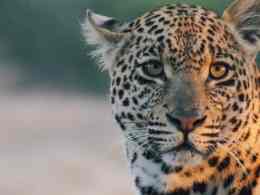The coyote is a medium-sized canine closely related to the wolf and dog. The animal is well-known for its howls, yips, and other vocalizations.
The scientific name given to the coyote means “barking dog.” The common name was generated from the Nahuatl word coyōtl.
Coyote Classification
- Scientific name: Canis latrans
- Common names: Coyote, prairie wolf
- Basic animal group: Mammal
- Size: 32 – 37 inches plus about 16 inches tall
- Weight: 20 – 50 pounds
- Lifespan: 10 years
- Diet: Omnivore
- Habitat: North and Central America
- Population: There are currently millions of coyotes
- Conservation status: Least concerned
Description
Coyotes, although slightly smaller than wolves, are larger than foxes. An average coyote adult can range from 32 inches in body length (excluding its tail), with a tail measuring up to 16 inches.
They typically weigh between 20 to 50 pounds. Although the sizes of coyotes vary depending on their habitat, female coyotes are shorter in length and height than males.
The color of their coat ranges from grayish brown to red, depending on the coyote’s habitat. Black (melanistic) forms occur, but you would rarely find albino or white coyotes. Coyotes have white belly and neck fur, with a dark-tipped tail.
Their long muzzle and pointed ears can characterize the face of a coyote. Similar to a fox, the coyote’s tail is brush-shaped also.
While the size of wolves and coyotes are arguably of the same proportion and coloration, coyotes have more sharply upright ears.
Their frame and face are leaner, and they pace or run around with their tail in a low position, while wolves have their tails in a horizontal position.
Habitat and Distribution
The original coyote’s range spanned from western North America’s deserts and plains through Mexico and Central America.
The annihilation of wolves in North America paved the way for expansion across the United States and even Canada.
Coyotes are seen from Panama in the south and across Alaska in the north. Surprisingly, coyotes have been able to adapt to nearly every habitat quickly.
They have been able to adapt to urban environments, too.
Diet and Behavior
Like other canines, coyotes are naturally omnivorous. They hunt snakes, rabbits, frogs (toads not included), deer, other ungulates, turkeys, and other birds of larger sizes.
While coyotes prefer their natural prey, they also hunt for lambs, chickens, calves, and pets. They also eat insects, carrion, fruit, and grass.
With their impeccable senses of smell and hearing, coyotes can detect prey at a great distance. They can also track their prey by sight. Coyotes are solitary predators and are great at hunting smaller prey.
Nevertheless, they usually form packs to hunt elk, deer, pronghorns, and sheep. Coyotes aren’t as social as wolves are, but they would collectively raise their offspring and hunt.
Reproduction and Offspring
Coyotes are naturally monogamous, and mating typically starts between February and April. Mating pairs would either build or look for dens for birthing and raising their pups.
Female coyotes give birth to between 3 and 12 pups just two months after mating.
Coyote pups can weigh between 0.44 and 1.10 pounds at birth. Puppies are born toothless and blind. While the mother coyote is busy nursing, the male hunts for food to return to the female.
Pups get weaned at two months of age, and they get physical with each other to establish dominance. Around June or July, the coyote family exits the den to hunt and cover their territory. They mark their territory with scratches in the ground and urinating in corners.
At eight months, young coyotes reach the same size as their parents and gain full weight when they are nine months old.
Coyotes leave their parents around August, but some may remain with their coyote family longer. Studies have shown that female coyotes that don’t mate the following year may help their sisters and mothers raise baby coyotes.
Coyotes in their natural habitat can live up to 10 years. While they may be on the food menu of mountain lions, bears, or wolves, most die from diseases, hunting, or automobile incidents. Coyotes kept as prey may live up to 20 years.
Hybrids
Wolves and coyotes sometimes mate, producing “coywolf” hybrids. Most North American wolves carry coyote DNA.
Although rare, dogs and coyotes sometimes mate to produce “coydogs.” Coydogs’ appearances differ, but they tend to retain coyotes’ solitary and shy nature.
Conservation Status
Coyotes are categorized as “least concerned” by the IUCN. The species have survived long enough to cover many ranges, with constant and increasing populations. So far, the greatest threat coyotes have are humans.
Coyotes and Humans
Coyotes have been hunted to protect livestock (poultry)and for their fur. Historically, coyotes were eaten by indigenous people and trappers.
These fantastic canines have adapted to human encroachments so well that there are presently populations of urban coyotes. Coyote pups are easily domesticated but don’t make ideal pets due to their shyness around strangers and odd scent.
Do you own a coyote? Have you had an encounter with a coyote? Do you think there are ways to ultimately make them ideal pets? Share your thoughts with us in the comments.




